by Winding Pathways | Aug 25, 2022 | (Sub)Urban Homesteading, Birds, Nature
While We Were Sleeping
We were tired on the evening of August 21. Crawling into bed at 9 pm we were oblivious to the traffic jam winging over our insulated roof. Late August. The fall bird migration has started. That night it picked up steam.
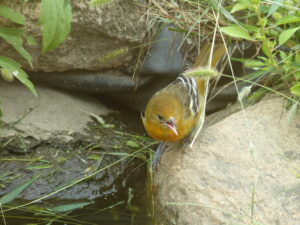
Birds stop for a drink and to fill up on the berries nearby.
In the morning we checked the BirdCast Migration Database and were astounded to learn that 883,000 birds crossed Linn County, Iowa, where we live, the evening before. Heading south, large numbers of birds began streaming overhead shortly after we turned off our reading lights. Migration usually starts just after sunset and peaks in the first couple of hours of darkness, but last night birds streamed over most of the night going south at an average speed of 26 miles an hour at an altitude of up to 2400 feet.
Technology Merged with Observation
How do we know? Well, we didn’t sit on the roof with night vision optics. We merely logged into the Cornell Laboratory of Ornithology’s Migration Dashboard at birdcast.info.
The technology is almost as fascinating as the information it reveals. The Live Migration videos show the action through the night. Fascinating!
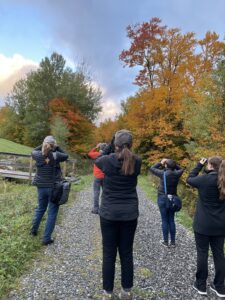
Pause to listen and look. Binoculars help.
The Lab collects data from 143 radar installations scattered across the country. This provides a clear picture of the number of birds migrating at any given time, their direction and speed, and how high they are flying. Radar can’t determine species, but years of data collected by ground observation and compiled by the Lab through eBird helps give an accurate picture of the likely species on the move. The list shows that probably 14 species went overhead while we slept.
Until a few years ago we were casual birders. The amazing science and sharing the Lab of Ornithology provides fascinate us and has sensitized us to the marvel and beauty of birds, their amazing navigation ability, their adaptations, and, unfortunately, the threats they face.
Apps Enhance Birding Experience
We have the Lab’s Merlin and Bird apps on our phone. The first is a pocket-sized field guide packed with more information than old paper field guides ever were able to provide. It helps us identify an unknown species, see its range, and even hear its calls and songs. A new feature helps identify birds by their song. Click it on and hold the phone toward where the call is coming from, and it identifies the species, usually correctly.
eBird enables us to easily compile a list of birds sighted on a particular day and forward our data to the Lab. Thousands of birders worldwide send their data, giving the Lab invaluable information on where birds are and how they move……as well as population trends.
Technology and Birds! What’s Not to Love?
Love technology? Love birds? These wonderful tools provided free from the Cornell University Laboratory of Ornithology merge the two. It’s a portal to many pages and other sites that include everything from nest webcams to detailed information about each species. Kudos to the Lab.
by Winding Pathways | Jul 28, 2022 | (Sub)Urban Homesteading, Birds, Nature
Views From the Recliner
Guest Blogger, Susan Fellows
My first-floor, corner apartment sits on the edge of a large green space and parking lot surrounded by a stand of pines, maples, and oaks. On one side is a complex of boutique stores, restaurants, and apartments/condos. Nearby and opposite the greenspace is a residents’ home for memory care. Last year I had placed outside my living room window a double shepherd’s crook feeder visible from my recliner. I am older and have some medical issues that restrict movement. So, a good view of the outside and the birds is important to me. They are entertaining! That first year I had what seemed like a million new sparrows that went through the wild bird seed like crazy. This year, I haven’t seen as many newly fledged sparrows.
Attracting a Variety of Birds
This year I put out several feeders on the double shepherd’s crook – one for black oil sunflowers and another for wild bird seed. Also on that post, I have a “cage” of suet and a sock of blick niger thistle seed. A couple of months ago I added a single shepherd’s crook with a mealy worm feeder. This spring and early summer I have seen pairs of the house and purple finches, house and chipping sparrows, several pairs of goldfinches, and at least one pair of bluebirds. They come to the sunflower and thistle seed, which the goldfinches seem to prefer. About a week ago, a mockingbird started coming and feeds entirely on the suet. Recently I put out wild bird food which hangs from the other hook on the double shepherd’s crook. I had put out mealy worms that I prefer the bluebirds have, but the house and chipping sparrows decided they own it. Flying over and calling from the grassy area are killdeer. With their shrill call, they are easy to spot as they hobble away with their fake broken wing act to lure predators from their ground nest. They nest in low vegetation, like the nearby grassy lawn.
-
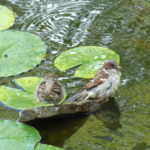
-
A water source helps attract birds.
-
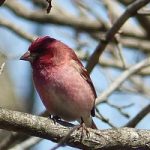
-
Some birds homestead at Winding Pathways.
-
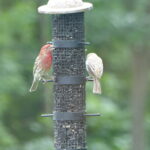
-
The house finches eat serenely.
Fledging Bluebird
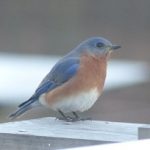
Male Bluebird
The memory home nearby has a bluebird nesting box on the quiet side of the building. I believe that is where the bluebirds come from.to feed. Several days ago I heard quite a racket from the feeding station. Looking outside, I spotted a fairly large bird with a highly streaked white breast, perched on the top of the single shepherd’s crook. An adult bluebird was also on the feeder. The bird making the racket had its beak open waiting for the adult to feed it. It didn’t. It was time for the baby to learn to eat on its own. At that point, I could see bright blue in its tail feathers. I was so excited! It was a baby bluebird!
Another day, I was looking out my window when suddenly a little, male chipping sparrow with his chestnut top on his head arrived bringing with him a smaller bird that landed close to him, beak open. Dad bird fed baby bird several pieces of seed and then showed baby bird how to do it, but as I watched baby still hadn’t got the hang of it.
Invasion by New Comers to the Feeder
A newcomer at the mealy worm feeder appeared recently – starlings. I was invaded by baby starlings. At least 15 had taken over the feeders. To lure them away from the hanging feeders, I put out a seed block on the ground at the base of the other feeders. Although I can’t see it, I expect the starlings may be happier at it than just eating crumbs from the open mealy worm feeder. I hope they will leave soon. They eat everything.
I have enjoyed sharing all these spring bird-related events with Winding Pathways. I expect to be inundated with newly fledged sparrows any time soon. Enjoy your birding adventures as I have enjoyed what I can see from my recliner.
by Winding Pathways | Jun 16, 2022 | (Sub)Urban Homesteading, Birds, Nature
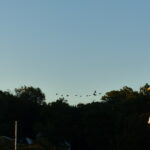
We enjoy the haunting call of geese on the wing.
One of nature’s most alluring sounds is the song of flying Canada geese. Years ago, one had to travel to remote marshes to enjoy it. Not anymore, and a mother goose in Cedar Rapids shows she enjoys urban life.
Giant Canada geese were once nearly exterminated, but a small flock was discovered. Volunteer groups and biologists carefully transplanted geese to new locations, often to urban ponds. Boy, did the huge birds ever love them!
Favorite Foraging
Canada geese love dining on short mowed grass. Lawns surrounding ponds in golf courses and condominiums are perfect habitat. The big birds don’t mind human activity or noise and have expanded so much that many people consider them pests.
Nesting Preferences
Usually, a goose pair chooses a hidden nest site. It may be near an urban area but often is in tall grass or bushes and is hard to spot. Not so one Cedar Rapids goose. She made her nest in a small island of woodchips and dandelions between a parking lot and road. Within sight is a movie theater, tattoo parlor, and medical building!
We are curious about how mom and dad plan to get the goslings to the nearest pond which is a distance away and through traffic.
-
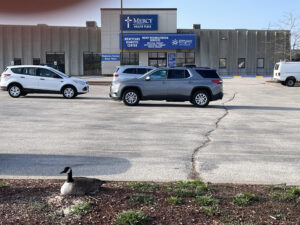
-
The staff have been watching the mother for several weeks.
-
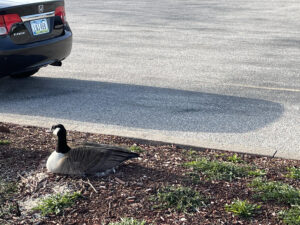
-
Geese are little bothered by traffic or noise.
Sitting, Hatching, and Raising
Goose eggs take about 35 days to hatch. Mom does the incubation but dad is normally close by and is a good protector. They mate for life and can live for decades. When the goslings hatch mom and dad lead them to a pond or river and teach them how to find food.
Our urban goose may be wise. The major nest threat is predation by dogs, raccoons, opossums, and skunks. They all avoid busy parking lots. So the goose couple may have chosen a safe nesting location…..or perhaps they just want to take in a movie, get a tattoo, or visit a doctor!
by Marion Patterson | May 12, 2022 | Birds, Garden/Yard, Nature, Trees
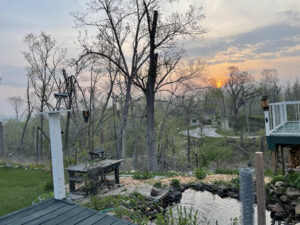 The distant view and the feel are “Hot August Days.” The near view and sounds are mid-May. With this hot weather, the trees have popped, the fruit trees are in full bloom, and the early garden plants emerging after the cooler and damp weather. We may break a century-old heat record today.
The distant view and the feel are “Hot August Days.” The near view and sounds are mid-May. With this hot weather, the trees have popped, the fruit trees are in full bloom, and the early garden plants emerging after the cooler and damp weather. We may break a century-old heat record today.
Two days ago we had the woodstove running. Now the air conditioner!
Notice the haze in the distance and the sun rising in the east – still six weeks from the Summer Solstice. Humidity levels are high. Winds are calmer after the front blew in.
The trees show emerging leaves and catkins. Insects work the fruit trees and low-growing spring flowers.
Birds are everywhere singing, courting, mating, and building nests. Amazing transformation in two days.
-
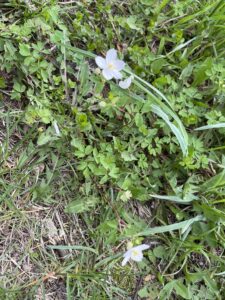
-
Deeply cut leaves of the false rue anemone.
-
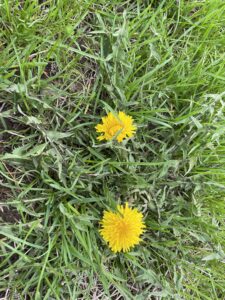
-
going at $8.00 per gallon at wineries, picking blooms from safe places is good income.
-
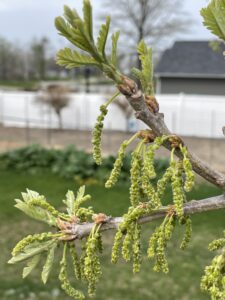
-
the oak popped out in one day with the heat.
-
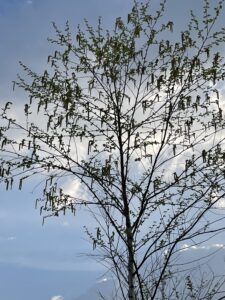
-
birds forage in emerging buds.
by Winding Pathways | May 5, 2022 | (Sub)Urban Homesteading, Birds, Nature
When recently walking for exercise at a cemetery our ears and then eyes alerted us to an amazing urban sound and sight.
Like most people, while walking we mostly watch the ground in front of us with occasional glances to the side and way forward. We don’t LOOK UP often enough, but the high-pitched cry was fascinating enough to stop us in our tracks to enjoy an upward view of a pair of ospreys circling their nest on the top of a cell phone tower.
We weren’t out in the country where we might expect a large raptor to nest. Rather the nest was above a lumber yard, restaurants, a liquor store, and a busy road.
Osprey
Ospreys are sometimes called fish hawks for their ability to catch and dine on fish. The nest we discovered was near a fish-swarming stream. People worldwide can enjoy this beautiful aerialist, as it has one of the largest ranges of any bird. It’s at home in Europe, Asia, Australia, Africa, and both North and South America.
Other Large Migrating Birds
LOOK UP. When we sit on our back deck LOOKING UP lets us spot migrating geese, pelicans, vultures, and even swans that we’d never see at ground level on our property. LOOKING UP lets us watch a pair of turkey vultures nesting in a huge hollow basswood near our house. LOOKING UP helps us spot massive bald eagle nests in the country and even in town. They seem to prefer nesting at the top of tall cottonwoods relatively close to water.
Ospreys are huge raptors and adept aerialists able to swoop down and pluck a fish from the water. They are pointy winged birds colored in black and white. Bald eagles are even bigger and also fish lovers. Supposedly our national bird sometimes hassles a fish-carrying osprey until it drops lunch that’s quickly recovered by the eagle.
National Bird
We’ve not seen this happen but apparently, our national bird is a skilled thief. Watch this video and note how the fishermen first hear the bird cries, spot the birds, put down their poles and catch the action on their phones. Listen, Look, Enjoy!
So, when walking or even sitting on the deck LOOK UP!
by Winding Pathways | Feb 10, 2022 | Birds, Mammals, Nature, Pests
Guest Blogger, Dr. No More Squirrels
(Photos by Dr. NMS)
Much of my time and energy has been spent battling a 1-pound enemy – the gray squirrel. I love feeding and watching birds, but with a neighborhood full of acorn-bearing oak trees I feel no guilt at all at not wanting to pay for bird food and letting the squirrels eat it. Through trial and error, I have found how to place all our feeders so that they are always out of the reach of squirrels. Almost always. Every few months a new guy shows up; a determined daredevil squirrel who figures out how to slide 20 feet down the string holding a feeder to get to the mother lode.
-
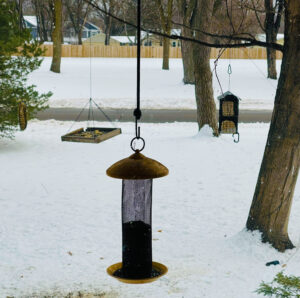
-
A variety of feeders for the birds.
-
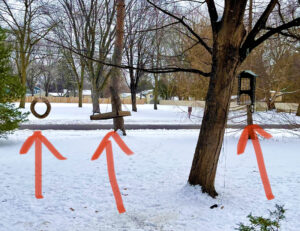
-
the “raiders” jump through hoops to get to the feeders.
When that happens, it’s time for an involuntary relocation.
This was the case on a frigid January morning here in Minneapolis. My live trap was set and within minutes I heard it snap shut. But what I then saw was a shock. The squirrel was trapped all right, but sitting next to the trap was an immature red-tailed hawk! She hopped onto the trap and all around it, trying to get at what she thought would be an easy breakfast.
Minutes later, she gave up and flew to a nearby perch to contemplate how she had been beaten by a 1-pound ball of gray fur.
I knew exactly how she felt.
-
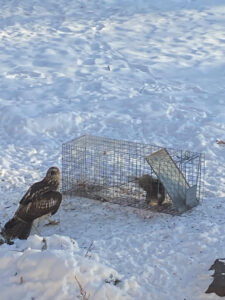
-
This immature red-tail hawk tries to figure out how to get the squirrel.
-
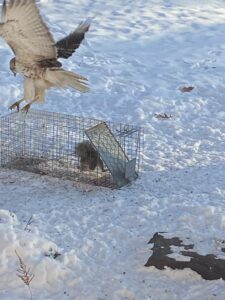
-
Landing on the trap










 The distant view and the feel are “Hot August Days.” The near view and sounds are mid-May. With this hot weather, the trees have popped, the fruit trees are in full bloom, and the early garden plants emerging after the cooler and damp weather. We may break a century-old heat record today.
The distant view and the feel are “Hot August Days.” The near view and sounds are mid-May. With this hot weather, the trees have popped, the fruit trees are in full bloom, and the early garden plants emerging after the cooler and damp weather. We may break a century-old heat record today.






